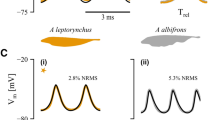Summary
-
1.
An in vitro preparation of the medullary pacemaker nucleus of the weakly electric fishApteronotus leptorhynchus was studied which fires regularly and synchronously at the fish's characteristic frequency of electric organ discharge (EOD). Upon bipolar stimulation of tissue regions through which pass prepacemaker nucleus afferents to the pacemaker, a brief, transient increase in discharge frequency ensued at short-latency (Fig. 1 A).
-
2.
Intracellular recordings revealed that the acceleration was accompanied by a depolarization and decline in action potential amplitude. The magnitude of these changes was both phase-(Fig. 5) and amplitude-dependent, with the latter showing an evident threshold effect (Figs. 4 and 12). The response was reversibly blocked by high Mg2+ saline (Fig. 1 B), and the magnitude of the accelerations showed marked facilitation during repeated stimulation (Fig. 6).
-
3.
Optical and histological identification allowed characteristically different responses in the intracellular recordings to be attributed to the two cell types of the pacemaker nucleus: pacemaker and relay cells (Figs. 2 and 3). Similar responses have been observed at these respective recording locations in the intact animal during chirping (Dye and Heiligenberg 1987).
-
4.
Simultaneous recordings of pairs of cells revealed a transient change in the phase relationship of firing during the accelerations which was most marked between relay and pacemaker cells (Fig. 7). These dual recordings also revealed that the relay cells depolarize and accelerate more than pacemaker cells (Fig. 10), suggesting that they are the principal effectors of this behavioral modulation.
-
5.
Trains of pulses additionally elicited a longlasting frequency elevation which occurred at a slightly higher threshold than the brief accelerations. This slow frequency change relaxed back to baseline following a biexponential time course which closely resembled that of a distinct behavior seen in intact fish, termed ‘yodeling’ (Dye 1987).
Similar content being viewed by others
Abbreviations
- Df :
-
difference frequency between two periodic signals
- EOD :
-
electric organ discharge
- JAR :
-
jamming avoidance response
- psp :
-
post-synaptic potential
- SD :
-
standard deviation
References
Bennett MVL, Pappas GD, Gimenez M, Nakajima Y (1967) Physiology and ultrastructure of electrotonic junctions. IV. Medullary electromotor nuclei in gymnotid fish. J Neurophysiol 30:236–300
Bullock TH (1969) Species differences in effect of electroreceptor input on electric organ pacemakers and other aspects of behavior in electric fish. Brain Behav Evol 2:85–118
Bullock TH (1970) Reliability of neurons. J Gen Physiol 55:565–584
del Castillo J, Katz B (1954) Statistical factors involved in neuromuscular facilitation and depression. J Physiol (Lond) 124:574–585
Dudel J, Kuffler SW (1961) Mechanism of facilitation at the crayfish neuromuscular junction. J Physiol (Lond) 155:530–542
Dye J (1987) Dynamics and stimulus-dependence of pacemaker control during behavioral modulations in the weakly electric fish,Apteronotus. J Comp Physiol A 161:175–185
Dye J, Heiligenberg W (1987) Intracellular recording in the medullary pacemaker nucleus of the weakly electric fish,Apteronotus, during modulatory behaviors. J Comp Physiol A 161:187–200
Dye JC, Meyer JH (1986) Central control of the electric organ discharge in weakly electric fish. In: Bullock TH, Heiligenberg W (eds) Electroreception. Wiley, New York, pp 71–102
Elekes K, Szabo T (1985) Synaptology of the medullary command (pacemaker) nucleus of the weakly electric fish (Apteronotus leptorhynchus) with particular reference to comparative aspects. Exp Brain Res 60:500–520
Enger PS, Szabo T (1968) Effect of temperature on the discharge rates of the electric organ discharge of some gymnotids. Comp Biochem Physiol 27:625–627
Grillner S, Wallen P, Dale N, Brodin L, Buchanan J, Hill R (1987) Transmitters, membrane properties and network circuitry in the control of locomotion in lamprey. TINS 10:34–41
Hille B (1984) Ionic channels of excitable membranes. Sinauer, Sunderland, Mass
Heiligenberg W (1986) Jamming avoidance responses. Model systems for neuroethology. In: Bullock TH, Heiligenberg W (eds) Electroreception. Wiley, New York, pp 613–649
Heiligenberg W, Finger T, Matsubara J, Carr C (1981) Input to the medullary pacemaker nucleus in the weakly electric fish,Eigenmannia (Sternopygidae, Gymnotiformes). Brain Res 211:418–423
Kawasaki M, Heiligenberg W (1988) Individual prepacemaker neurons can modulate the pacemaker cycle of the gymnotiform electric fish,Eigenmannia. J Comp Physiol A 162:13–21
Kawasaki M, Maler L, Rose G, Heiligenberg W (in press) The anatomical and functional organization of the prepacemaker nucleus in gymnotiform fish: accommodation of two behaviors in one nucleus. J Comp Neurol
Larimer JL, MacDonald JA (1968) Sensory feedback from electroreceptors to electromotor pacemaker centers in gymnotids. Am J Physiol 214:1253–1261
Magleby KL (1979) Facilitation, augmentation, and potentiation of transmitter release. Prog Brain Res 49:175–182
Maler L, Boland M, Patrick J, Ellis W (1983) Localization of zinc in the pacemaker nucleus of high frequency gymnotid fish. In: Frederickson CJ, Howell GA, Kasaroulis EJ (eds) The neurobiology of zinc. Part A: Physiochemistry, anatomy, and techniques. Liss, New York, pp 199–212
Meyer JH (1984) Steroid influences upon the discharge frequencies of intact and isolated pacemakers of weakly electric fish. J Comp Physiol A 154:659–668
Meyer JH, Leong M, Keller CH (1987) Hormone induced and maturational changes in electric organ discharges and electroreceptor tuning in the weakly electric fishApteronotus. J Comp Physiol A 160:385–394
Rose G, Kawasaki M, Heiligenberg W (1988) ‘Recognition units’ at the top of a neuronal hierarchy? Prepacemaker neurons inEigenmannia code the sign of frequency differences unambiguously. J Comp Physiol A 162:759–772
Schmidt RS (1984) Neural correlates of frog calling: preoptic area trigger of ‘mating calling’. J Comp Physiol A 154:847–853
Szabo T, Enger PS (1964) Pacemaker activity of the medullary nucleus controlling electric organs in high frequency gymnotid fish. Z Vergl Physiol 49:285–300
Tokunaga A, Akert K, Sandri C, Bennett MVL (1980) Cell types and synaptic organization of the medullary electromotor nucleus in a constant frequency weakly electric fish,Sternarchus albifrons. J Comp Neurol 192:407–426
Author information
Authors and Affiliations
Rights and permissions
About this article
Cite this article
Dye, J. An in vitro physiological preparation of a vertebrate communicatory behavior: chirping in the weakly electric fish,Apteronotus . J. Comp. Physiol. 163, 445–458 (1988). https://doi.org/10.1007/BF00604899
Accepted:
Issue Date:
DOI: https://doi.org/10.1007/BF00604899




